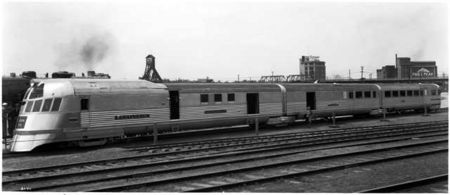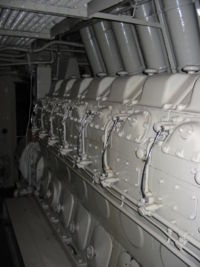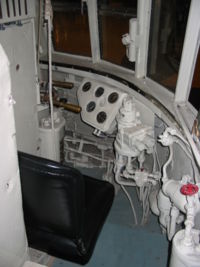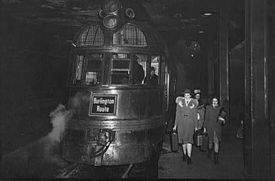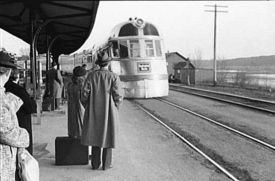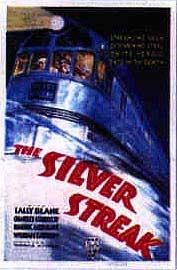Pioneer Zephyr

The Pioneer Zephyr is a diesel-powered railroad trainset (a set of railroad cars permanently coupled together, actually an articulated railcar with Jacobs Bogies) built by the Budd Company in 1934 for the Chicago, Burlington and Quincy Railroad (CB&Q), commonly known by the shorter name of Burlington. The train, which featured extensive use of stainless steel, was originally named Zephyr and was meant as a promotional tool to advertise passenger rail service in the United States. The train's construction included innovations such as shotwelding (a specialized type of spot welding) to join the stainless steel, and articulation to reduce the train's weight.
On May 26 1934 it set a speed record for travel time between Denver, Colorado, and Chicago, Illinois, when it made a 1,015-mile (1,633 km) non-stop "dawn-to-dusk" dash, covering the distance in 13 hours 5 minutes at an average speed of 77 mph (124 km/h). For one section of the run, the train reached a speed of 112.5 mph (181 km/h), just short of the then-US land speed record of 115 mph (185 km/h). The historic dash inspired two films and the train's nickname, "Silver Streak".
The trainset entered regular revenue service on November 11 1934 between Kansas City, Missouri, Omaha and Lincoln, Nebraska. It was operated on this route until its retirement in 1960 when it was donated to the Museum of Science and Industry in Chicago where it remains on public display. The train is generally regarded as the first successful streamliner on American railroads.
Contents
Concept and construction
In the early 1930s, the U.S. was in the depths of the Great Depression. Without the money to purchase new goods, freight trains weren't hauling as much as they had in the previous decade. People who couldn't buy goods also couldn't afford to travel to the extent that they had before, so passenger revenues were also down. Even if they did have the money to travel, the equipment that railroads were using to carry passengers hadn't changed much since the middle of the 19th century. Railroads needed a way to re-energize the traveling public and offer a bit of hope for the days to come.
One of the railroad presidents who faced this challenge was Ralph Budd, formerly of the Great Northern Railway and now president of the Chicago, Burlington and Quincy Railroad (Burlington), who needed a new train to get the public interested in traveling again. The name of the new train came from The Canterbury Tales, which Budd had been reading. The story begins with pilgrims setting out on a journey, inspired by the budding springtime and by Zephyrus, the gentle and nurturing west wind. Budd thought that would be an excellent name for a sleek new traveling machine - Zephyr.
In 1932 Ralph Budd met Edward G. Budd (no relation), an automotive steel pioneer who was founder and president of the Budd Company. Edward Budd was demonstrating his new carbody construction in a prototype rail motorcar built of stainless steel. Stainless steel provided many benefits over traditional wood and hardened steel for railroad carbodies; it was a lighter and stronger material, and its natural silver appearance and resistance to corrosion meant that it wouldn't have to be painted to protect it from the weather. Since the carbody was much lighter than similar cars, it would be able to haul a higher revenue load for the same cost.
The problem with building stainless steel cars was that nobody could find an adequate way to hold the body together, until the Budd Company patented the shotwelding technique. On August 20 1932, Earl J. Ragsdale, an engineer at the Budd Company, filed for a patent on "Method and product of electric welding"; on January 16 1934, the United States Patent and Trademark Office assigned U.S. Patent 1,944,106 to the Budd Company to cover the technique. Basically, because of the nature of stainless steel, traditional welding methods would unacceptably weaken the metal at the joint. In a shotweld, the two pieces of metal that are to be joined are pressed together at the joint with an electrode on each side of the joint. A very high current of electricity is passed through the joint which effectively fuses the two pieces of metal together.
Another factor in making the Zephyr lighter than conventional trains was that the individual carbodies in the train share their trucks with adjacent cars. The train was essentially three articulated compartments. On conventional passenger cars, each carbody rode upon a pair of trucks (wheel/axle assembly), with one truck at each end. The articulation not only reduced the number of trucks under the train, but it also dispensed with the need for couplers between each of the carbodies, further reducing the train's weight.
The first Zephyr was completed by Budd Company on April 9, 1934, powered by an 8 cylinder, 600 horsepower (447 kW), 8-201-A model Winton Motor Company engine (the train's prime mover). Like the diesel-electric locomotives that would soon displace the steam locomotive on American railroads, this engine powered an electrical generator; the electricity it generated was then fed to electric traction motors connected to the axles in the train's front truck.
The exterior design of the train was left to aeronautical engineer Albert Dean who designed the sloping nose shape, with architect John Harbeson and industrial designer Paul Philippe Cret devising a way to strengthen and beautify the sides with the train's horizontal fluting.
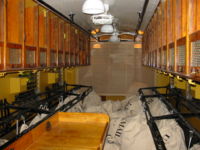
The train's engineer sat in a small compartment in the nose of the train, directly in front of the prime mover. Behind the engine in the first carbody was a 30-foot (9.1 m) long railway post office section. The second carbody consisted of a small baggage section and a short buffet and 20-passenger coach section. The third and final carbody in the train, as it was originally built, was configured as half-coach (40-passenger seats) and half-observation car (12 passenger seats). As built, the train had 72 seats and could carry 50,000 pounds (22.7 tonnes) of baggage and express freight. This train's official christening occurred on April 18 1934, at the Pennsylvania Railroad's Broad Street Station.
The Budd Company used the experience learned in building the Zephyr to build similar trains (such as the Flying Yankee) for other railroads, as well as a number of additional Zephyrs for the Burlington.
Promotion: "Dawn-to-Dusk" dash
To catch the public's attention, however, this train wasn't simply rolled out of the factory for some dignitary to smash a bottle of champagne on its nose; it would make a dash from one end of the CB&Q, in Denver, to the other in Chicago. The railroad spared no expense in planning the operations. All other trains along the Zephyr's route were diverted to sidings and the turnouts were spiked into the proper alignment for the Zephyr's run. Track and maintenance of way workers checked every single spike and bolt along the train's route to ensure that there would not be any problems, and temporary speed signs were installed along the route to warn the Zephyr's driver of curves that would be dangerous at high speeds. On the day of the dash, every road grade crossing was manned by a flagman to stop automobile traffic ahead of the train and to ensure that the crossing was clear. Stations along the route were protected by local police officers and members of the American Legion and the Boy Scouts of America.
The train left Denver at 7:04 AM Central Daylight Time and arrived in Chicago at 8:09 PM, a total of 13 hours and 5 minutes later, at an average speed of 77 mph (124 km/h). For one section of the run, the train reached a speed of 112.5 mph (181 km/h), just short of the then-world land speed record of 115 mph (185 km/h). The non-stop 1,015 mile (1,633 km) trip exceeded the railroad's expectations by making the run one hour and 55 minutes faster than was scheduled. Reporters along the route told of the "silver streak" that ran by faster than any other train that normally rode American rails at the time. The Burlington's contemporary passenger trains plied the same distance in around 25 hours.
Riding the train for this run were Ralph Budd, Edward G. Budd, president H. L. Hamilton of the Winton Motor Company (at that time a part of the new General Motors Electro-Motive Division), a number of reporters, some Burlington employees, lucky members of the public, and Zeph, a burro that was contributed by a Colorado newspaper, the Rocky Mountain News, as a mascot for the train. The newspaper had described Zeph to the railroad as a "Rocky Mountain Canary" so the train's crew had originally planned only enough space for a birdcage; when they found out it wasn't a bird, the railroad hastily built a pen in the baggage section and bought some hay for it. When asked about the burro, Ralph Budd replied "Why not? One more jackass on this trip won't make a difference."
After the train arrived in Chicago, it traveled a little farther to the 1934 Century of Progress fair (noted in some press articles about the dash as the "Chicago World's Fair") where it was put on public display on opening day. After its display on the Wings of a Century stage, the train was taken on a 31-state, 222-city publicity tour. More than 2 million people saw the train before it entered revenue service.
Part of the tour included a test run between Chicago and Minneapolis-St. Paul that operated a full five hours faster than the Burlington's fastest steam-powered train along the same route. Due to the Zephyr's success on this test run, the Burlington immediately ordered two more Zephyr trainsets that would be dubbed the Twin Zephyrs; the new trains debuted in April 1935 on this route.
Regular revenue service
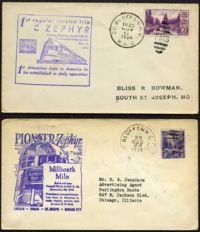
The Zephyr's power (leading) car was numbered 9900, the baggage-coach combine car was numbered 505, and the coach-observation was numbered 570. The trainset was placed in regular service between Kansas City, Missouri, Omaha and Lincoln, Nebraska, on November 11, 1934, replacing a pair of steam locomotives and six heavyweight passenger cars. The Zephyr replaced a train weighing up to eight times as much. By June 1935, it proved popular enough to add a fourth car to the train's regular configuration, providing additional coach seating. The fourth car was originally a 40-seat coach number 525, but the following June was switched to Twin Cities service, then back to the Pioneer Zephyr in December. Car 525 remained on the train until June 1938. Just over five years after it was introduced, the Pioneer Zephyr crossed the one million mile mark in regular service on December 29 1939, near Council Bluffs, Iowa.
Ralph Budd and the Burlington capitalized on the Zephyr's success. However, most passenger trains needed larger capacity. Thus, as the Burlington made a transition to larger diesel-electric locomotives pulling individual passenger cars, new streamlined cars of standard-size were ordered, which quickly became the standard of many railroads. However, Burlington was determined to be the leader, and ordered its large "E" series passenger diesels to also be equipped with matching stainless-steel fluting. Many of the Burlington's long distance named passenger trains began operating under the Zephyr banner, including the Nebraska Zephyr, Twin Cities Zephyr, and perhaps the most famous of the namesake, the California Zephyr.
On the second anniversary of the train's famous dash, the original Zephyr was rechristened as the Pioneer Zephyr to distinguish it as the first of the Burlington's growing Zephyr fleet. In 1938, car 525 was replaced with car number 500, a 40-seat buffet/lounge car to provide light meals during the train's travels. Car number 505, the baggage-coach combine, was also rebuilt at this time into a full baggage car, but it kept the windows as they were originally installed.
In regular service, the Pioneer Zephyr had its share of accidents on the railroad. In 1939 it was involved in a head-on collision with a freight train that completely destroyed the trainset's control cab. The trainset was rebuilt and re-entered revenue service soon afterward, but the accident strengthened the opinions of locomotive designers to move the cab back from the front of the locomotive up above a large nose (as can be seen in the EMD F-unit and EMD E-unit series locomotives).
Since the Pioneer Zephyr was built of stainless steel, which is not as recyclable as aluminum, the train was spared from the metal recycling drives of World War II. By contrast, Union Pacific Railroad's M-10000 was built of aluminum and was scrapped in 1942 for the war effort, among other reasons.
In 1948 and 49, the Pioneer Zephyr was temporarily removed from service to participate in the Chicago Railroad Fair's "Wheels A-Rolling" pageant. The fair's purpose was to celebrate 100 years of railroad history west of Chicago, and Pioneer Zephyr's role in the pageant was to highlight the latest strides in railroad technology. It resumed regular passenger operations when the fair ended on October 2 1949.[1] By 1955 the Pioneer Zephyr's route had been updated to run between Galesburg, Illinois, and Saint Joseph, Missouri; the trainset had been in continual service since 1934, operating over nearly 3 million miles (4.8 million kilometres). The Pioneer Zephyr's last revenue run was a trip from Lincoln, Nebraska, to Kansas City, Missouri, (along the train's regular revenue route) that then continued to Chicago on March 20, 1960. When Amtrak took over passenger rail services in 1971, the legendary Zephyr name was preserved, and the California Zephyr is an Amtrak route in the 21st century.
Use in film
Press publicity had apparently first coined the term "Silver Streak". The Pioneer Zephyr's famous Denver-Chicago dash served as the inspiration for the 1934 film Silver Streak starring Charles Starrett. In that story, the crew was racing to the Boulder Dam construction site with an iron lung, with only moments to spare. The original Zephyr trainset was used for the exterior shots in the film, while interior scenes were filmed on a soundstage in Hollywood. For the film, the "Burlington Route" nameplate on the train's nose was replaced with one that read "Silver Streak".
More than 40 years later, that classic film – or at least the name "Silver Streak" – served as the inspiration for a newer film of the same name. Silver Streak (1976) starred Gene Wilder and Richard Pryor; rather than using the Pioneer Zephyr, the combination murder-mystery and comedy was set in the era in which it was filmed, with the train being patterned more after then modern long-distance trains.
Legacy: Preservation and static display and namesakes
On May 26 1960, the 26th anniversary of the "Dawn-to-Dusk" dash, the original Pioneer Zephyr trainset (car numbers 9900, 505 and 570) was donated to the Chicago Museum of Science and Industry. Car number 500, which operated with the train starting in 1938, went along with Mark Twain Zephyr trainset 9903 to a party in Mount Pleasant, Iowa, for static display in a town park, but plans for the train's display did not work out; car 500 and the Mark Twain Zephyr are currently stored in Chicago and plans are currently underway to display it in Fairfield, Iowa.
The Chicago museum displayed the Pioneer Zephyr outside the museum, with no protection from the weather, until 1994. At that time, the steam locomotive that shared the display space with the Zephyr, Santa Fe #2903, was donated to the Illinois Railway Museum, while the Chicago museum prepared a new display location for the Zephyr.
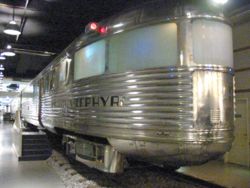
The Chicago museum dug a pit in front of the building and built a new display area for the Zephyr where it could be displayed year-round. In 1998, after the train received a cosmetic restoration by Northern Rail Car, in Milwaukee, Wisconsin, the pit was finally ready to receive the train. The Pioneer Zephyr train is still on display at the museum just outside the main entrance from the underground parking area for the museum, where it is one of the more popular exhibits.
In addition to the Pioneer Zephyr, two other legacies exist in modern time. An operable Nebraska Zephyr train was donated to the large Illinois Railway Museum at Union, west of Chicago. There, powered by one of the large "E" series passenger diesels (an EMD E5) with the distinctive and durable stainless-steel fluting, it is still operated on short runs on the Museum's substantial trackage, providing train enthusiasts and tourists with an experience reminiscent of the heyday of the Burlington's Zephyr service.
Also utilizing the famous name, the Minnesota Zephyr is an elegant dining train located in the historic city of Stillwater, Minnesota, although it is not directly associated with the historic Burlington Zephyr fleet.
Dorney Park & Wildwater Kingdom in Allentown, Pennsylvania has a miniature replica train ride called Zephyr which was built in 1935 and helped the park survive the Great Depression.[2]
Models of the Pioneer Zephyr
Due to the Zephyr's place in American railroad history, many model railroaders have built their own versions of the Pioneer Zephyr in miniature. Several model manufacturers are now producing commercial ready-to-run models or kits of the train for modelers to build. This list is sorted by the manufacturer's release date:
- American Flyer produced a ready-to-run Pioneer Zephyr model in S scale (1:64) in 1965.
- Challenger Imports imported limited production ready-to-run brass models in HO scale (1:87) of the 4-car Pioneer Zephyr, Mark Twain Zephyr and the Boston and Maine Railroad's Maine Cheshire and Maine Minuteman in 1993.
- Fine N-Scale Products released a kit in 1996 in N scale (1:160) that includes an option for car number 500.
- Con-Cor made a limited-run model available in both HO scale and N scale that were released in 2005.
- River Raisin Models released a ready-to-run model in S scale of both the Pioneer Zephyr (in three- and four-car configurations) and the similar Flying Yankee. These models were also released in 2005.
- MTH Electric Trains released a limited production ready-to-run model of the three-car Pioneer Zephyr in O scale (1:48) in 2005
See also
- Flying Yankee - A very similar streamlined trainset that operated on the Boston and Maine Railroad; it is undergoing restoration to operating condition as of 2006.
- Nebraska Zephyr - Another of Burlington's Zephyr fleet, one example of which is preserved at the Illinois Railway Museum.
- "Fliegender Hamburger" ("Flying Hamburger"), a German diesel trainset entering service in 1933, performing regularly at speeds of up to 100 mph.
References
- American Society of Mechanical Engineers (November 18 1980), The Pioneer Zephyr (PDF). Retrieved February 24 2005.
- Chicago Museum of Science and Industry, excerpts from the New York Times (May 27 1934), Pioneer Zephyr - A Legendary History. Retrieved February 24 2005.
- Chicago Museum of Science and Industry (2002), Pioneer Zephyr, a legendary history - The Dawn To Dusk Club. Retrieved March 1 2005.
- Gordon-Gilmore, Randy (2002), Pioneer Zephyr. Retrieved February 24 2005.
- Johnston, Bob, and Welsh, Joe, with Schafer, Mike (2001). The art of the streamliner. Metro Books, New York, NY. ISBN 1-58663-146-2.
- Lotz, David (Spring 2002), History of the Mark Twain Zephyr. Retrieved February 27 2005.
- PBS Online / WGBH (2000), American Experience / Streamliners / People & Events / Ralph Budd. Retrieved February 22 2005.
- Ragsdale, Earl J. W., (August 20 1932), Patent number 1,944,106 - Method and product of electric welding (PDF). Retrieved February 27 2005.
- Trackside, The Pioneer Zephyr comes home. Retrieved February 25 2005.
- (February 2005) Trains Timeline, Trains Magazine, p. 9.
- Wayner, Robert J., ed. (1972). Car names, numbers and consists. Wayner Publications, New York, NY.
- Zimmerman, Karl (2004). Burlington's Zephyrs. MBI Publishing Company, St. Paul, Minnesota; reprint by Andover Junction Publications. ISBN 0-7603-1856-5.
- ↑ Chicago Railroad Fair Official Guide Book (1949).
- ↑ Dorney Park & Wildwater Kingdom (2006). Rides: Zephyr. Retrieved on 2006-06-15.
Further reading
- Morgan, David P. (1963). Diesels West. Milwaukee, Wisconsin: Kalmbach Publishing. LCCN 62019987. Chronicle of the rise of diesel power on the Burlington with specific emphasis on the Pioneer Zephyr, its record-setting run, and its descendants.
- Rediske, R. W. (2002). The Pioneer Zephyr. Authorhouse. ISBN 1-4033-5125-2. The author of this book was a passenger aboard the "dawn-to-dusk" run in 1934.
External links
- Museum of Science and Industry in Chicago official website - The current home of the Pioneer Zephyr
- Zephyr Patents - PDF reproductions of the patents developed for construction of the Pioneer Zephyr.
- Illinois Railway Museum official website - Home of many more Burlington artifacts, including the Nebraska Zephyr trainset.
- The Burlington Pioneer Zephyr - site with photographs of the Pioneer Zephyr trainset on outdoors display in Chicago.
Limited production and export locomotives built by EMD | |
|---|---|
| Electrics | SW1200MG · AEM-7 · GM6 · GM10 · GF6C |
| Industrial, military, export and narrow gauge | Model 40 · DDM45 · DHI · GMDH-1 · GMDH-3 · MRS-1 · GA8 · G8 · G12 · G16 · G26 · NF110 · NF210 · JT42CWR (Series 66) · JT42HW-HS · GT46MAC · GT22HW · GT46PAC |
| Streamliners | M-10000 · M-10001 · M-10002 · M-10003-6 · Pioneer Zephyr · General Pershing Zephyr · Green Diamond · Flying Yankee · Aerotrain |
| Experimentals | 1800 hp B-B |
| See also: List of EMD locomotives | |
